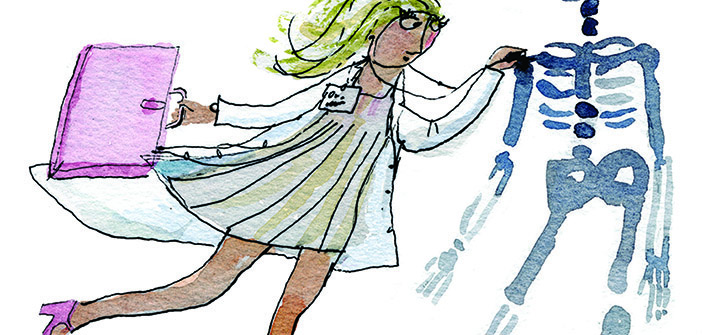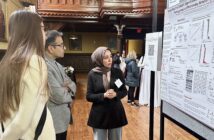To succeed in a male-dominated field, be yourself.
I carry a pink briefcase. Not a subtle pink, but a vivid, intense, practically bubble-gum pink. I set it down each morning among the ubiquitous black backpacks, drab brown briefcases, and camouflage baseball hats. I finish rounds and attend morning lecture, where the speaker invariably scans the room and identifies me as the only female in a sea of male orthopedic residents.
When I first arrived at Brown, in 2011, I was the fifth woman in the program, and at 16 percent female, our program matched the national average for orthopedics. However, as each successive Match Day yielded six men and no women, that number fell. And finally, as a fourth-year resident, I was the lone woman in the annual orthopedic residency photo, standing proudly in fuchsia high heels.
In medical school, senior attendings in multiple specialties tried to convince me that orthopedic surgery was for male jocks and athletic has-beens, and a female orthopedic resident told me that the only way to fit in was to chest bump my way through residency and “act like a man.” I questioned my choice. During residency interviews I was frequently asked what sort of things I did with my hands. Could I play the ukulele? Could I build a shed? Did I whittle wooden animal figurines? After I stared back blankly for a few seconds, I quickly endorsed my ability to shop for shoes online and my penchant for baking. Did participating in stereotypically female gender role activities make me unable to do orthopedic surgery? Despite my hesitance, I matched into orthopedics, believing in my passion for the patients, the surgeries, and their outcomes.
In the last five years, I have been called into my program director’s office because I have been easily identified as “the lady doctor,” for both the good and the bad (thankfully more frequently for the good). I have been told I’m too young or too pretty to be a surgeon, and that’s when I’m not mistaken for the nurse, physical therapist, or dietary aide. Yet I would choose it all again. The satisfaction of fixing fractures, restoring quality of life, and improving a patient’s pain and disability has far outweighed any of the perceived, or actual, negatives. I embrace being a woman in a department that has embraced me. I learned how to succeed while contributing a much-needed female perspective in a male-dominated field.
According to AAMC data, orthopedic surgery residencies and fellowships across the nation rank behind only interventional radiology and interventional cardiology for the lowest percentage of women. I have two female mentors among more than 30 attending surgeons in our department, both of whom are strong advocates for women in orthopedic surgery. Together we have spoken at interest groups, held workshops, and invited medical students to spend time with us, all in an effort to prove that orthopedic surgery is an amazing, fulfilling career for anyone.
Until these efforts translate into an increase in female orthopedic residents, there is significant work left to do. For now, I will continue to answer questions about what it’s like to spend my days surrounded by male colleagues (a little smellier and messier) and gently remind patients that my junior resident is not their surgeon despite his Y chromosome. I will then take my sparkly lead to the operating room, use a collection of power tools, and fix one more patient. When that patient walks into my office at follow-up, I will have a smile of satisfaction on my face. And maybe some delicious baked goods.




